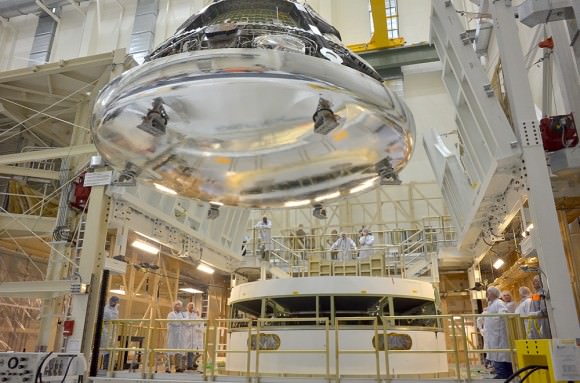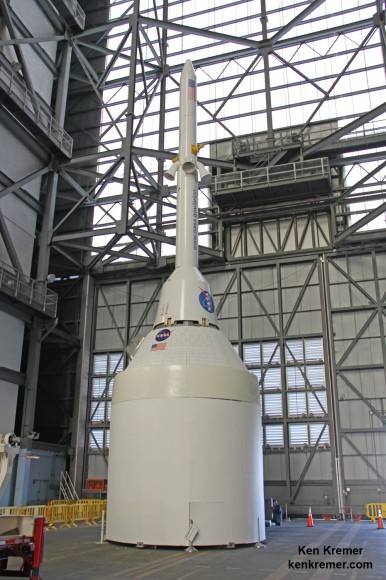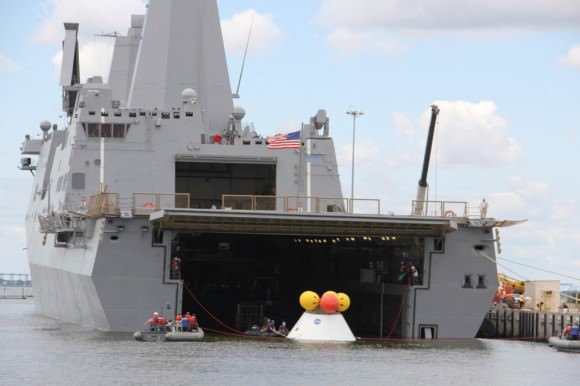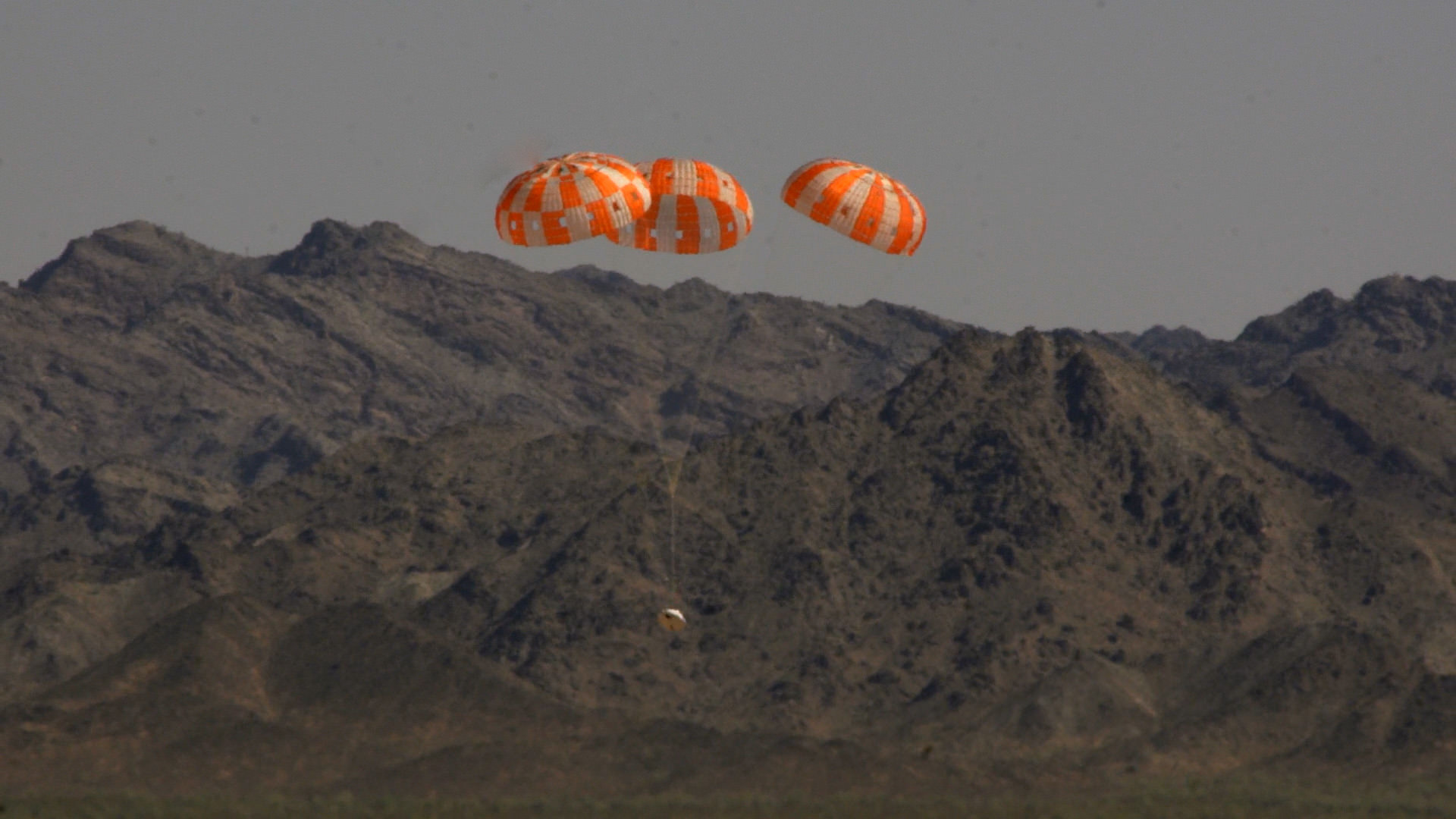A test version of NASA’s Orion deep space capsule has completed its most complex and last full flight-like parachute drop test on June 25 ahead of the maiden launch on the EFT-1 mission now slated for early December 2014.
The descent test was conducted at an altitude of 35,000 feet over the Arizona desert at the U.S. Army’s Yuma Proving Ground by pulling the test vehicle out of a huge C-17 cargo aircraft.
The test also included the addition of several added stress tests to check out the ability of the parachute system to compensate and examine capsule and astronaut crew survival via several potential failure modes.
For example, engineers rigged one of the main parachutes to skip the intermediate phase of the three-phase process to unfurl each of Orion’s three parachutes, called reefing.
“This tested whether one of the main parachutes could go directly from opening a little to being fully open without an intermediary step, proving the system can tolerate potential failures,” according to NASA.
The goal is to prove that that parachute system will slow Orion to ensure a safe landing speed for the astronaut crews returning from deep space missions to the Moon, Asteroids and eventually Mars.

“We’ve put the parachutes through their paces in ground and airdrop testing in just about every conceivable way before we begin sending them into space on Exploration Flight Test (EFT)-1 before the year’s done,” said Orion Program Manager Mark Geyer in a state
“The series of tests has proven the system and will help ensure crew and mission safety for our astronauts in the future.”
Orion is slated to launch on its inaugural unmanned EFT-1 test flight in December 2014 atop the mammoth, triple barreled United Launch Alliance (ULA) Delta IV Heavy rocket from Cape Canaveral, Florida.

This test also marked the last time that the entire parachute sequence involving the deployment of all three 116 foot-wide main chutes will be tested before the December launch.
For some of the parachutes, this was the highest altitude drop test attempted.
“Engineers also put additional stresses on the parachutes by allowing the test version of Orion to free fall for 10 seconds, which increased the vehicle’s speed and aerodynamic pressure,” NASA noted in a statement.
The parachute deployment and unfurling can only begin after jettisoning of the spacecraft’s forward bay cover. The chutes are housed below the cover which protects the chutes until reentry into Earth’s atmosphere.
The two-orbit, four- hour EFT-1 flight will lift the Orion spacecraft and its attached second stage to an orbital altitude of 3,600 miles, about 15 times higher than the International Space Station (ISS) – and farther than any human spacecraft has journeyed in 40 years.
One of the primary goals of NASA’s eagerly anticipated Orion EFT-1 uncrewed test flight is to test the efficacy of the heat shield in protecting the vehicle – and future human astronauts – from excruciating temperatures reaching 4000 degrees Fahrenheit (2200 C) during scorching re-entry heating.
At the conclusion of the EFT-1 flight, the detached Orion capsule plunges back and re-enters the Earth’s atmosphere at 20,000 MPH (32,000 kilometers per hour).
“That’s about 80% of the reentry speed experienced by the Apollo capsule after returning from the Apollo moon landing missions,” Scott Wilson, NASA’s Orion Manager of Production Operations at KSC, told me during an interview at KSC.
The parachute system comprising of two drogue parachutes and a trio of main parachutes – nearly the size of a football field – will then unfurl to slow Orion down to just 20 mph for a safe splashdown and recovery by the US Navy in the Pacific Ocean.

Another drop test scheduled for August will test the combined failure of one drogue parachute and one main parachute, as well as new parachute design features, says NASA.
Meanwhile, Orion’s prime contractor Lockheed Martin is finishing assembly and test operations of the EFT-1 capsule inside the Operations and Checkout Facility (O & C) at the Kennedy Space Center (KSC) flying in December’s launch
Stay tuned here for Ken’s continuing Orion, Orbital Sciences, SpaceX, commercial space, Curiosity, Mars rover, MAVEN, MOM and more planetary and human spaceflight news.


The Orion Capsule is SO retro with it’s obvious Apollo era aerodynamic design, that it could just as easily be called the Apollo Mk. II! Not that this is such a bad thing because after all is said and done, Apollo worked. But still, am sure that many of us aerospace fans would have preferred something a little more advanced or even radically different.
That said, I still like/prefer the innovative SpaceX approach to landing on rockets next to the pad it took off from, a reusable booster and potential for rapid turn around and reuse.
They use old tech and have redesigned it enough to get rid of all advantages from proven technology. It is expensive, oldfashioned and risky. But I’m glad they make progress anyway! Resurrecting the capability NASA had 50 years ago would be great. A new engineer might get the same job her grandfather had, that’s at least not anti-progress.
They tested the LDSD Mars landing heat shield yesterday. Not that I understand why NASA develops gadgets which have no foreseable use in their future mission plans. NASA will never put a human on Mars, someone else will. Someone who understands how to make priorities and how to organize action. NASA is getting nowhere.
“They tested the LDSD Mars landing heat shield yesterday. Not that I understand why NASA develops gadgets which have no foreseable use in their future mission plans. NASA will never put a human on Mars, someone else will.”
That technology can land bigger crafts. That does not mean that it needs to be humans. Also the technology tested can be used in other missions and new patents.
It’s not all about Mars. General aerospace technology development is a large part of NASA’s reason for being. This particular tech would be useful in a number of aerobraking/aerocapture scenarios, at a number of bodies with meaningful atmospheres…including Earth.
It is only the shape that is similar, all the rest is completely different.
And I actually like this design.
I just want to add, the steering for such a design during descent is actually simple. The center of gravity is off center, so steering it up and down left and right is just a matter of one single RCS control: Rotation.
The EFT-1 mission is exciting, and I am looking forward to it.
However, I think it will be the only Orion to fly. Surely, the Dragon will fill the role of both a manned or unmanned space capsule in the future.
Dragon cannot go deep-space.
Orion will fly. Re-election votes in jobs sustained congressional districts depend on it!